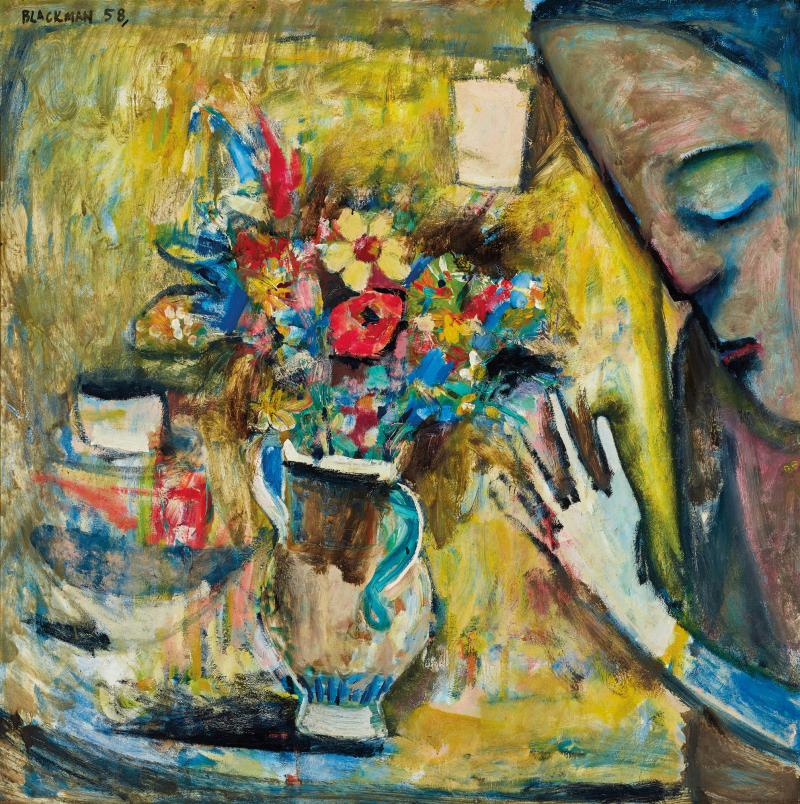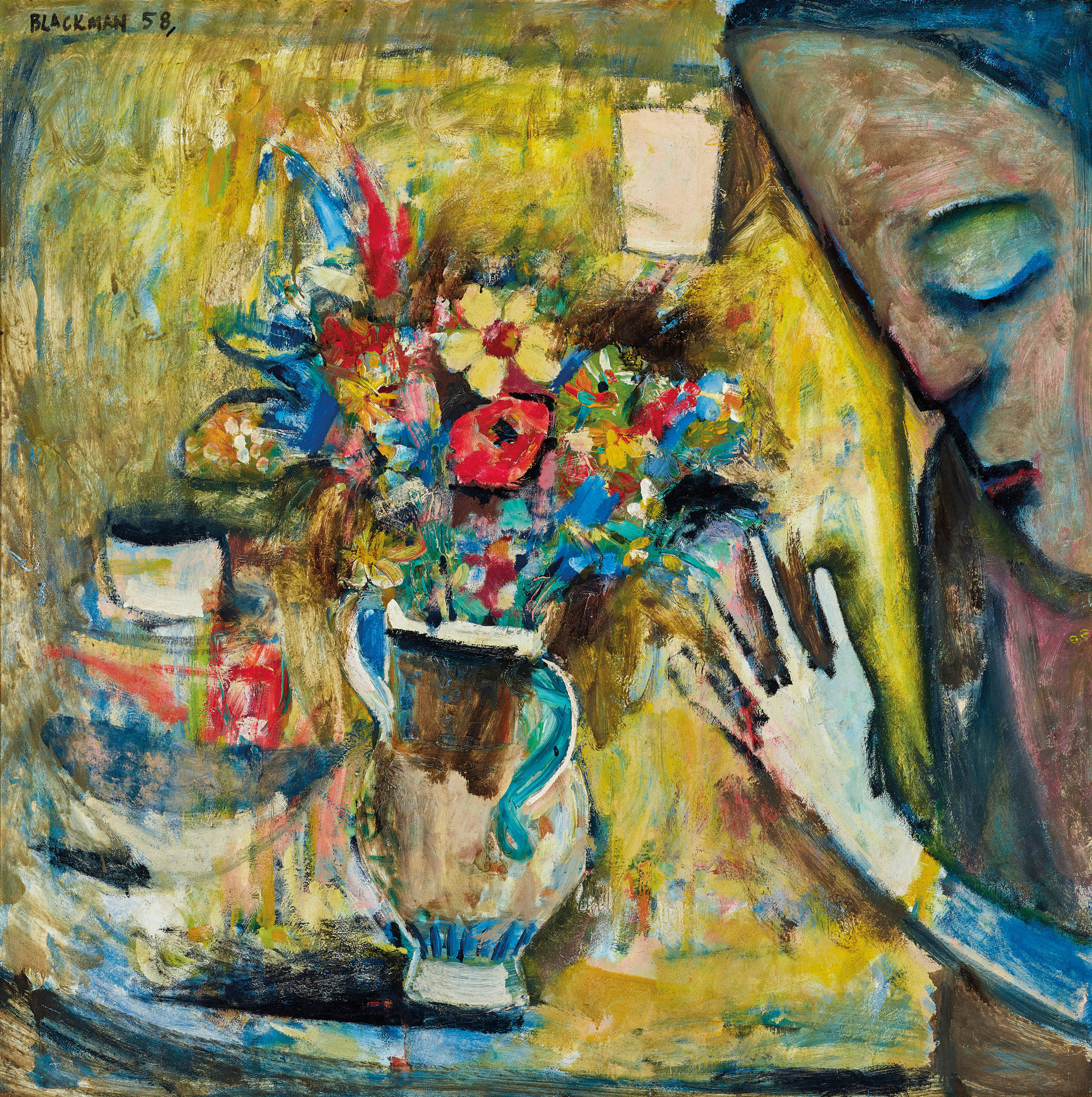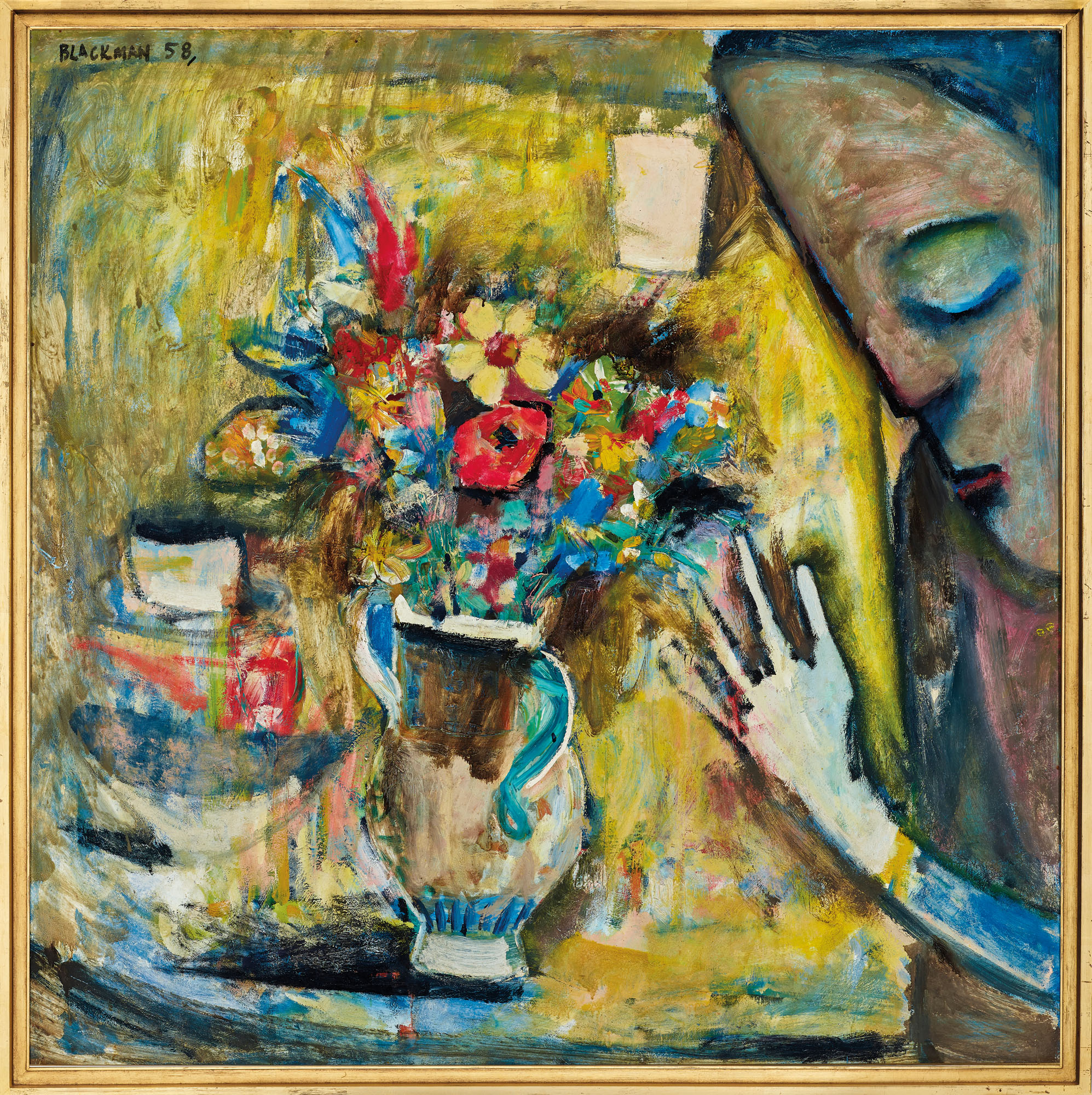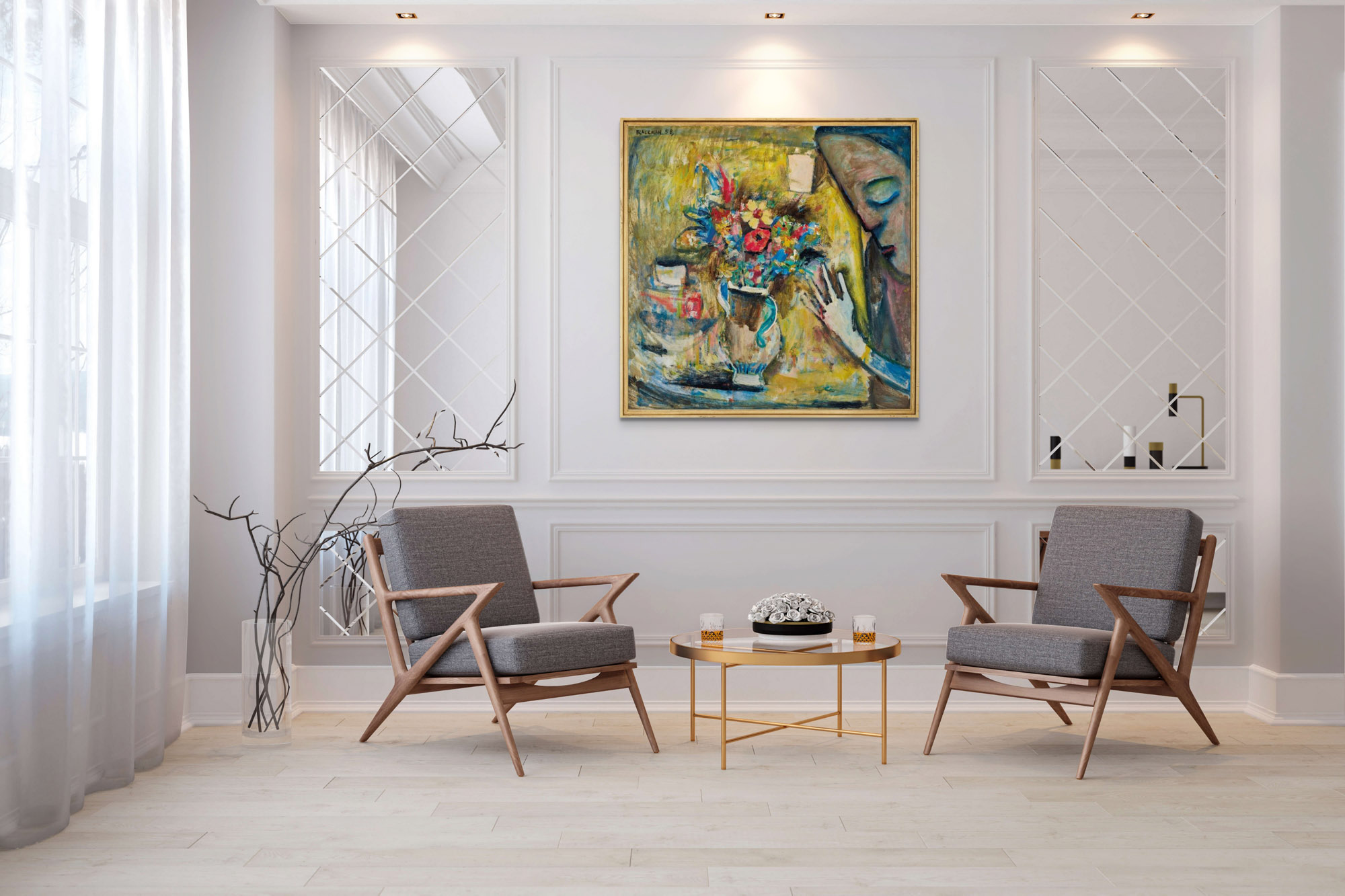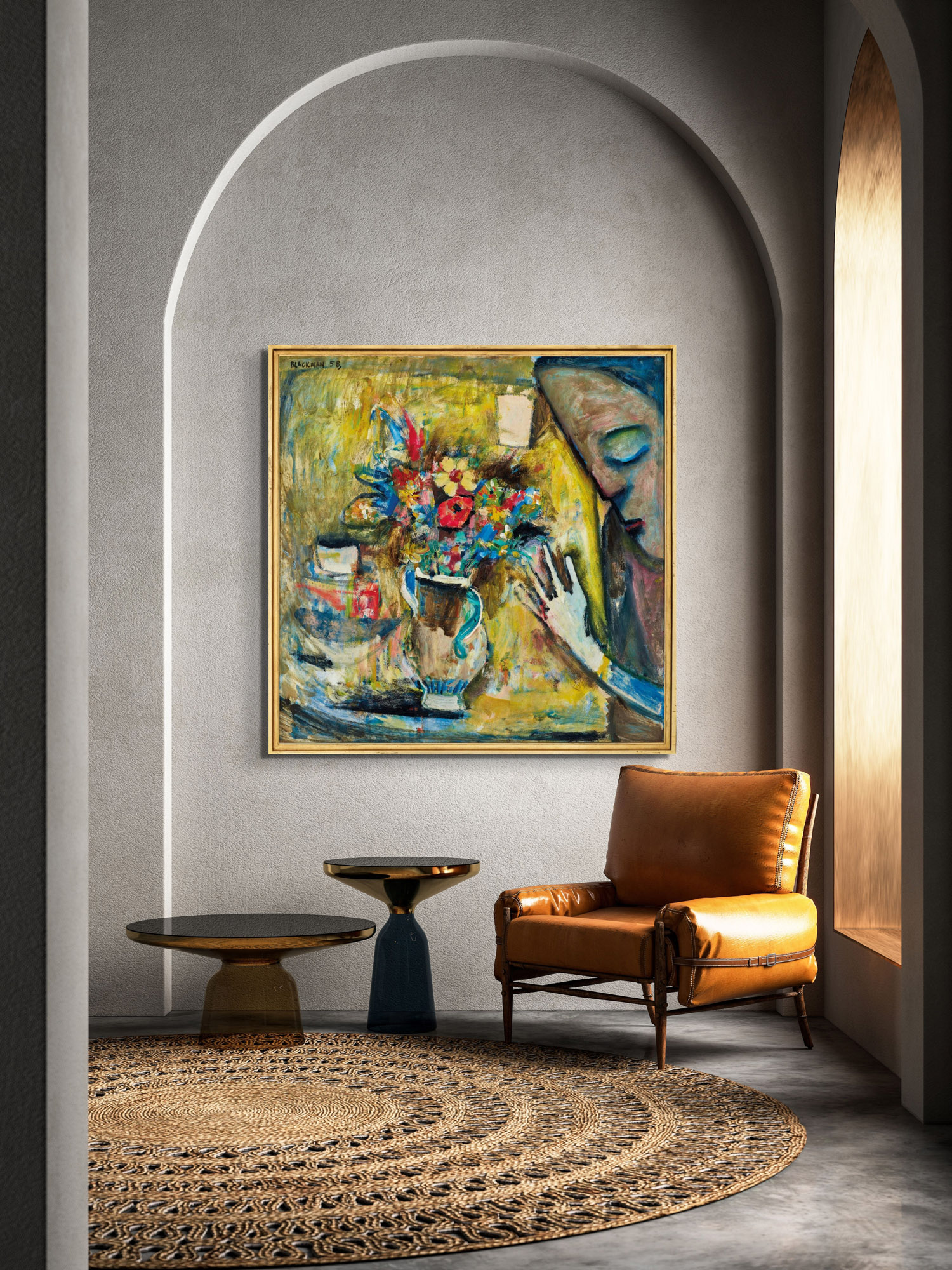CHARLES BLACKMAN (1928-2018)
Day Dream 1958
Estimate: $200000 - 250000
Sold For:
$220000 hammer
$270000 inc. buyer's premium
Description
CHARLES BLACKMAN (1928-2018)
Day Dream 1958
oil on board
122.0 x 122.0 cm; 130.0 x 130.0 cm (framed)
signed and dated upper left: BLACKMAN 58/
signed verso: CHARLES BLACKMAN
bears inscription verso: "DAYDREAM"/ CHARLES BLACKMAN/ 45 CHRYSTOBEL CRESC./ HAWTHORN/ WA2148/ 1856N5
Provenance:
The Johnstone Gallery, Brisbane
Private collection, Melbourne
Exhibited:
Charles Blackman: Faces and Flowers, The Johnstone Gallery, Brisbane, 17 November - 5 December 1958, cat.20
Antipodeans, Victorian Artists' Society, Melbourne, 4-15 August 1959, cat.5
Related Works:
Reverie 1958, oil on board, 101.6 x 76.2 cm, illus. in Shapcott, T., The Art of Charles Blackman, Andre Deutsch Limited, London, 1989, p.137, pl.71
Estimate: $200000 - 250000
Result Hammer: $220000
In 1958, when Charles Blackman painted Day Dream, he was enjoying the peak of his early recognition. The 30-year-old painter had already completed his Schoolgirls and Alice series that are now found in all of the major Australian public art collections. He was achieving critical acclaim; in 1958, one of his 1958 Alice paintings entered the collection of the Musée d'Art Moderne de Paris, and the exhibition in which Day Dream was shown in the recently relocated Johnstone Gallery, in Cintra Road, Bowen Hills in Brisbane, was his first financially successful show. The following year, Blackman exhibited with a group of other figurative artists in Bernard Smith’s Antipodean exhibition in Melbourne with its controversial manifesto, and in 1960 he was awarded the highly prestigious Helena Rubenstein Travelling Scholarship that took him and his family to London.
Day Dream belongs to Blackman’s Faces and Flowers series, where the artist juxtaposes a floral tribute with a female face. It was a series that had numerous reiterations throughout Blackman’s career with the face of his wife Barbara employed in many of the works, including this painting. One source for this series may lie in the art of the French symbolist artist Odilon Redon (1840-1916), whom Blackman admired from an early age. Felicity Moore, who curated the major Blackman retrospective exhibition at the National Gallery of Victoria, writes, ‘in Blackman’s mind, Redon handed him the flame and he has never put it down. “Redon represents something very precious,” he says, “the paintings he invented are as radical as any Velasquez but they are about something else: the soul.”’1
Moore continues, ‘his empathy with Redon was clearly intensified by a certain correlation in their experience, for instance between his wife Barbara’s thoughtful profile in Girl and Yellow Bouquet [The University of Western Australia Art Collection] and the sphinx-like figures in Redon’s paintings, such as The Druidess, and between Barbara’s stillness of listening (contingent partly on blindness) and the profound and mysterious silence in Redon’s work.’2
In Redon’s art, figures with closed eyes relate to a state of sleep or death and allude to an inner world, to dreams, apparitions or absence. In Blackman’s Day Dream, the female figure has her eyes closed and is shown reaching out with her hand to the flower still life on a table next to her as a way of absorbing the flowers through touch and smell rather than sight. Blackman’s wife, Barbara, had poor eyesight from birth. She was diagnosed with optic atrophy and was legally blind by 1950 when she was 22. When Day Dream was exhibited in Brisbane, the perceptive art critic, Dr Gertrude Langer, observed that, ‘his art … speaks tenderly of suffering and joy, dreams and memories. His colours, brilliant as they are, are not employed for their own sake, but for their emotional import ... a painter who speaks to the heart is to be treasured.’3 When referring to the series of figure with flowers paintings, Langer noted, ‘bathed in a light that has its source in the luminous colours, these inward gazing faces full of a gentle sadness, these flowers, which often seem like souls of flowers, have a stringent poetry that lingers in the mind.’4
In the 1950s, the Blackmans were living in Melbourne, in a house that Barbara Blackman describes as, ‘a forgotten coach-house stable and loft behind an old Victorian mansion in Chrystobel Crescent in Hawthorn, befitting a marriage and a studio.’5 However, when their first child, Auguste, was born in April 1957, they spent much of their time in Brisbane living near Barbara’s mother and her luxuriant garden and frequently visited the flower farms surrounding Mount Tamborine. It is likely that this painting was executed in Queensland with its rich floral display, although appropriately, on the rear of the painting the artist gives his Melbourne address, as after the opening of the Johnstone Gallery exhibition, Blackman was back in Hawthorn meeting with fellow exhibitors in the proposed Antipodean exhibition.
Blackman spoke of this series of paintings in an interview in 1966. ‘The flowers evoked the people, in a certain kind of gentility, or substance, or reverence, or sensitivity … Barbara sitting down next to a bunch of flowers, or seen through a bunch of flowers.’6 Although the motif of a woman next to a bunch of flowers in 20th century art is largely associated with Marc Chagall (1887-1985) and Blackman admired Chagall’s work, by 1958 he took full ownership of the subject and made it into a deeply moving spiritual experience where Barbara appears to dream the flowers into being.
Blackman was essentially a self-taught artist and it was while he was in Brisbane that he met with the artist and teacher Jon Molvig (1923-1970) who gave him some tips on employing gestural brushwork. In contrast with the preceding Schoolgirls and Alice series of paintings with their relatively flat surfaces, Day Dream has a dynamic, gestural surface with bold choppy brushstrokes and energetic slashes of colour. The figure of Barbara, despite being in the foreground, is cast into shade with a restrained palette and earthy colours edged with blue, while the subject of the daydream, the floral tribute, bursts into a brilliant and vibrant palette with red and yellow blooms.
Day Dream is a beautiful, classic and significant Blackman painting that through its profound lyricism and rich sonorous palette evokes the spiritual state of a waking dream, one that is tinged with melancholy.
Footnotes
1. Moore, F., Charles Blackman: Schoolgirls and Angels: A Retrospective Exhibition of Paintings and Drawings by Charles Blackman, National Gallery of Victoria, Melbourne, 1993, p.2
2. Ibid.
3. Langer, G., Courier Mail, Brisbane, 18 November 1958
4. Ibid.
5. Blackman, B., Glass After Glass: Autobiographical Reflections, Viking, Melbourne, 1997, pp.150-51
6. Shapcott, T., Focus on Charles Blackman, University of Queensland Press, Brisbane, 1967, p.36
Sasha Grishin
Sasha Grishin AM, FAHA is an Emeritus Professor at the Australian National University, Canberra and Guest Curator at the National Gallery of Victoria, Melbourne. He is the author of over thirty books on art, including Australian Art: A History (The Miegunyah Press, Melbourne, 2013).
Specialists
-

Cameron Menzies, Chairman & Head of Private Sales
cmenzies@menziesartbrands.com
+61 (0) 466 636 142 -

Asta Cameron, Art Specialist
acameron@menziesartbrands.com
+61 (0) 400 914 088 -

Clementine Retallack, Front of House Manager & Associate Art Specialist
cretallack@menziesartbrands.com
+61 (0) 478 493 026
Location
Sale & Exhibition Details
-
Auction
27 March 2024
6:30PM AEDT
1 Darling Street
SOUTH YARRA VIC 3141
artauctions@menziesartbrands.com -
Exhibition
-
Sydney
14-17 March 2024
10:00AM to 5:00PM AEDT
12 Todman Avenue
KENSINGTON NSW 2033
art@menziesartbrands.com -
Melbourne
21-26 March 2024
10:00AM to 5:00PM AEDT
1 Darling Street
SOUTH YARRA VIC 3141
artauctions@menziesartbrands.com
-
